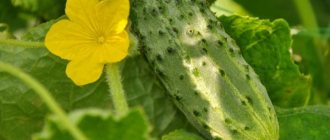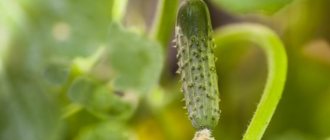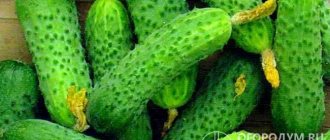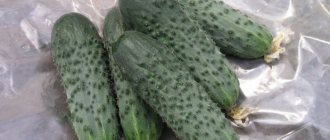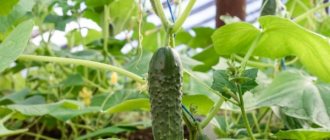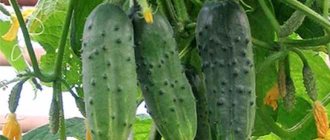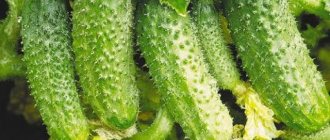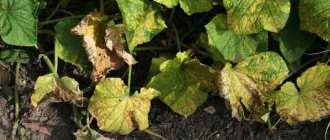Maresa F1, subject to available agricultural technology, pleases gardeners with good yields of neat and tasty gherkins. The self-pollinating hybrid bears fruit consistently, regardless of the region.
| Landing location | Ripening time | Mode of application | Fruit length | Group | Fruit smoothness | Pollination method |
| Universal | Mid-early (46-55 days) | Universal | Short (gherkins) - less than 10 cm | Hybrid | Highly lumpy | Parthenocarpic |
Description and characteristics of the variety
The fruits are smooth and neat, great for preparing a variety of dishes. Among the signs of gherkins:
- length 8-9 cm;
- weight 60-70 g;
- diameter 2-2.5 cm;
- tubercles are large, frequent,
- pubescence is white;
- the consistency is dense, crispy;
- the skin is bright green;
- seed chambers are rudimentary.
Advantages and disadvantages
- precocity;
- versatility of use;
- significant productivity;
- disease resistance;
- resistance to temperature changes;
- wonderful taste and canning characteristics.
Minuses:
- the importance of regular watering.
Mares cucumber F1 variety description
Order cucumber seeds Mares F1
Dear customer, here you can buy Mares F1 cucumber seeds in bulk directly from the manufacturer Seminis. All seeds are carefully selected and processed in production, packaged in high-quality packaging, protected from light and moisture, which guarantees safety and germination. We provide a discount for orders over 50 thousand rubles, we deliver to all regions of the Russian Federation, we send seeds by mail or transport companies. After placing your order, a manager will contact you to clarify the details.
Characteristics of the Mares F1 variety from the State Register of the Russian Federation
Included in the State Register of the Russian Federation for cultivation under film covers in private household plots. Early ripening, parthenocarpic, salad, canning. The plant is indeterminate, medium branched, female flowering type. The number of female flowers in a node is 1-3. The leaf is medium sized, green to dark green. The plant is short, cylindrical, green, coarsely tuberculate, white pubescence, of medium density. Weight of greens is 65 g. The taste is excellent. Marketable yield 11.0 kg/sq.m. Resistant to cladosporiosis, VOM and MR. Information taken from the official website of the Federal State Budgetary Institution “State Commission of the Russian Federation for the Testing and Protection of Selection Achievements” (FGBU “State Sort Commission”)
Leave feedback
Reviews are moderated before publication.
Your rating Please introduce yourself * Email *
| Enter the number * |
Review text * Send review
No one has left a review here yet. You can be the first!
Our advantages
| 14 manufacturers |
We present the products of 14 seed producers from around the world
| Distributors |
We are official distributors and dealers
| 42 Regions |
42 regions are already working with us
| 2000 |
More than 2000 varieties in the company’s assortment
| 5 000 ₽ |
5,000 ₽ — minimum order amount
Similar products
Growing and care
The hybrid is easy to care for. Cultivation is carried out according to the general rules for cucumbers:
- watering taking into account the stage of vegetation (before flowering once every 3-4 days, after budding once every 2 days);
- fertilizing once every 10-14 days (alternating the addition of organic matter and minerals);
- formation due to accelerated growth of branches;
- prevention of aphid and whitefly infestations.
All currently available varieties of cucumbers can be relatively divided into 3 large groups according to their ripening period: ultra-early, early and mid-ripening. Each of these groups has its own pros and cons. But in the spring, ultra-early varieties of cucumbers are especially popular among summer residents, allowing them to enjoy their own grown cucumber in the shortest possible time. Depending on the circumstances of cultivation, they can be systematized into varieties for open and closed ground.
Pros and cons of the variety
Like other varieties of this crop, Mares f1 cucumbers have a number of positive features. However, unlike most varieties, they have virtually no negative characteristics. Let's consider a description of the pros and cons of growing the Maresa variety:
pros
- Excellent taste characteristics;
- Resistance to most diseases;
- Quite early and long-term fruiting;
- Weather resistance;
- Excellent presentation;
- Resistance to transportability;
- Versatility of use: suitable not only for fresh consumption, but also for preparing salads, as well as for pickling.
Minuses
Gardeners were able to identify only one drawback of cucumbers - the need for systematic watering.
Ultra-early ripening varieties of cucumbers
Ultra-early ripening varieties and hybrids are capable of forming ovaries in a very short time. The fruits retain all their sweetness and density.
Maresa
In first place is the Mares cucumber (considered a parthenocarpic hybrid). One of the fastest ripening species. It is possible to start harvesting already on the 36th day. Zelentsy grows in the form of a cylinder with large tubercles, 9.5 cm long. It rarely gets sick and tolerates temperature fluctuations well.
Baby
This is an early ripening species. You can enjoy cucumbers already on the 39th day. They are covered with large tubercles with a snow-white edge, regular, rounded shape. The variety resists many diseases and tolerates low temperatures.
Saracen F1
Provides a rich harvest, rarely gets sick and tolerates bad weather well. Belongs to a parthenocarpic, early plant species. It begins to bear fruit on the 38th day. Straight, tubular-type greens grow up to 14.5 cm in length. There are tubercles with small spines on the surface.
Karaoke F1
On the 39th day, after planting the seedlings, Karaoke will produce a sufficient harvest. Regularly shaped greens up to 12 cm in length are formed with large tubercles. The hybrid tolerates heat well and is resistant to many infections.
kids
It is considered a bee-pollinated, early-ripening hybrid. Fruits can begin to be collected after 42 days. It stands out for its rich harvest with excellent taste. Tubular greens are covered with small tubercles. Plant immediately with seeds or seedlings.
Moscow dude
They will give you fruits after 41 days. For the purpose of pollination, free access to insects is required. The green fruits have snow-white stripes and small spines. The length of the greens is approximately 10 cm. The yield will please every vegetable grower. The Moscow Dude variety is resistant to many diseases, especially bacteriosis.
Ataman F1
Belongs to the parthenocarpic species. Characterized by indeterminate growth and medium branching. Fruiting occurs after 42 days. Fruits with frequent tubercles reach 15 cm. Fruiting persists at low temperatures and low light levels. Resists infections well.
Little Raccoon
The species begins to form as early as 40 days. It is considered a self-pollinating hybrid. The lashes are short and small in size. The fruits grow up to 9 cm in length, are covered with rare tubercles with snow-white spines, and have light stripes. Expresses stability to a specific number of diseases.
Advance F1
It begins to enter the fruiting period after 42 days. It is considered a determinate, parthenocarpic type of cucumber, with branched side shoots. Zelentsy are short, with small snow-white stripes and tubercles with a snow-white edge. They resist disease well and produce large quantities of sweet, crunchy fruit.
Features of care
The unique f1 requires labor-intensive and painstaking care. This variety requires abundant watering and fertilizers, frequent weeding and timely loosening so that water does not stagnate at the roots.
How often to water
The variety is moisture-loving, so it is watered every day. The best time for watering is late evening, and pour water under the cucumber without touching the leaves. Hybrid Unique f1 requires water at room temperature, standing for 20-25 minutes in the sun. In dry weather, the bushes are watered every day.
Formation of bushes
A unique f1 is formed into one stem. The bush is subjected to the following procedures:
Cucumbers cultivated under film can be grown horizontally, spread out, but greenhouse bushes are formed only vertically.
Fertilizer
This cucumber loves abundant and nutritious feeding. Fertilize it 3-4 times a season. During the period of active growth of the variety, nitroammiaphosphate is added. Before flowering - mullein solution, or humus. At the moment of formation of the ovaries, Unique is fed with superphosphate, or chicken droppings. Liquid fertilizers are preferable; they are applied after 20-30 minutes. after watering.
Growing
The beds to grow early and super early varieties of cucumbers must be prepared in the fall. In the autumn, the soil must be thoroughly dug up and fertilized with manure or group fertilizers with a large amount of phosphorus and potassium, but without chlorine.
The following vegetable and green crops are considered the best predecessors for cucumbers:
The sowing period for film is the earliest and in the conditions of the central zone of the Russian Federation is May 10-15. After mass germination of cucumber seeds, it is necessary to monitor the soil moisture, as well as:
- Sowing seeds for seedlings must be done approximately a month before planting the plants on the ridges.
- From the 2nd decade of April, weather favorable for sowing early cucumber seeds sets in.
- When sowing cucumbers for seedlings in a greenhouse very early, there is still a significant possibility of return spring frosts; for this reason, it is necessary to protect the crops as much as possible from lower temperatures.
- When directly sowing cucumbers in open ground prematurely, it is imperative to provide short-term cover for planting.
Landing
To obtain early gherkins, seeds are sown on seedlings from the end of March. Use a nutritious, well-drained substrate. Bushes are transplanted to the site at the age of 25-27 days.
From the end of May, seeds can be sown directly into the garden bed - holes, furrows. The depth of the soil is 3-4 cm. An important condition is that the earth warms up to 14-15 degrees.
The placement density is no more than 3 bushes per 1 m2.
Description
This variety is parthenocarpic, that is, setting and filling of fruits occurs without the participation of pollinating insects.
The hybrid variety of cucumbers “Marinda F1” is characterized by a female type of flowering and a tendency to bunch ovaries
Parthenocarpy in cucumbers is a natural property, fixed through long-term selection at the level of a stable trait, and is not related to genetic modifications (GMOs). Since seeds do not ripen in unfertilized fruits, products at the stage of consumer ripeness have high marketability:
- uniform appearance, uniform size and color of 90-100% greens;
- transportability and keeping quality of the harvested crop during long-term storage.
In addition to the listed advantages, “Marinda F1” cucumbers have great yield potential due to the female type of flowering and bunch fruiting. When the plants are fully nourished, bunches are formed in the nodes, consisting of 5-7 ovaries, which are poured en masse and together. The yield of commercial quality fruits in greenhouse conditions reaches 25-30 kg/m2.
The harvest is formed on the 40-55th day after emergence; many vegetable growers note its stability and duration throughout the entire growing season of the plant.
The bushes of this hybrid are medium-sized and moderately climbing, which facilitates formation, care and harvesting
The plant is unlimited in growth (indeterminate), but at the same time quite open and not dense - medium-sized, moderately climbing, with small leaves. It is recommended to grow it both vertically (on a trellis or mesh) and horizontally (without supporting structures). The cucumber hybrid “Marinda F1” is unpretentious in care, well adapted to adverse weather conditions, has high stress resistance and environmental plasticity, and is not susceptible to common viral and fungal diseases: cucumber mosaic, olive spot and powdery mildew.
Gherkins of this variety are considered ideal for all types of canning - salting and pickling.
“Marinda F1” has gained particular popularity due to the versatility and excellent taste of greens. The hybrid is one of the most popular short-fruited varieties of cucumbers, intended for all methods of canning and fresh consumption. Green gherkins (8-10 cm long, about 3 cm in diameter, weighing on average 65-70 g) have a cylindrical shape and a dark green color with short light stripes. The peel is covered with large tubercles with white pubescence. The pulp is juicy and crispy, dense, uniform consistency, with small seed chambers. Zelentsy have a distinct fresh aroma and a pleasant sweetish taste, completely devoid of bitterness.
If harvested untimely, cucumber greens “Marinda F1” tend to grow thick, which makes them look barrel-shaped.
The photo shows packages of seeds of the hybrid variety of cucumbers “Marinda F1” from various manufacturers
Since when growing hybrid cucumbers, only purchased seed material is used, germination, survival rate of seedlings, and compliance with the declared varietal characteristics depend on its quality. Many foreign and domestic companies are engaged in the production and sale of seeds of the Marinda F1 hybrid.
Often the packages indicate that the seeds are coated or encrusted. Externally, they are distinguished by their bright turquoise or pink color with a pearlescent tint.
You can find out what cucumber seeds “Marinda F1” from agro look like and what you should pay attention to when purchasing them from the following video:
With regard to seeds covered with protective and nutritious shells, it is important to understand that before planting they cannot be subjected to pre-treatment: soaking, disinfection or hardening. The shell contains micro- and macroelements that stimulate growth and provide protection for young plants from diseases and pests. After sowing such seeds, it is important to water the soil abundantly so that the shell dissolves and does not interfere with germination.
Breeding work to improve the consumer properties of well-proven cucumber hybrids is ongoing. As a continuation of the “Marinda F1” line, Dutch specialists from Seminis have created:
| Name | Year of inclusion in the State Register of Russia |
| "Madita F1" | 2008 |
| "Maresa F1" | 2011 |
| "Masha F1" | 2000 |
| "Meringue F1" | 2007 |
| "Monisia F1" | 2011 |
Despite the emergence of a huge number of new products, the hybrid cucumber “Marinda F1” still enjoys well-deserved trust and high demand among Russian vegetable growers.
In the photo - packages of seeds of daughter hybrids bred on the basis of Marinda F1 cucumbers
Care
The hybrid variety of Mares cucumbers is unpretentious in care, but requires systematic watering of the soil. Care procedures include watering, tying up bushes, loosening the soil, as well as preventive spraying of bushes against diseases and pests.
Watering
Water the cucumbers early in the morning or late in the evening, but not when the sun is scorching. The water temperature must correspond to the soil temperature, so the liquid is heated or infused in the sun.
It is recommended to water once every 4 days before flowering and once every 2 days after flowering.
Garter and bush formation
Mares f1 cucumbers need tying up and bush formation. This is due to the fact that the branches of the bushes grow quite quickly and reach a height of up to 2 m, therefore, the branches break and create a shadow for the rest of the bushes.
To tie the branches, use a thick rope. It is fixed at a height of 2 m, and the base of the branch is not tightly wrapped with rope. Thus, the branches of the plant cling to the rope and grow along it.
Top dressing
It is recommended to fertilize cucumber bushes once every 2 weeks. In this case, it is advisable to alternate between nutrients: organic matter and minerals.
In addition, it is recommended to spray the bushes of the plant so that the cucumbers are not attacked by pests such as aphids or whiteflies.
Diseases and pests
The Skipper variety is very resistant to dangerous diseases of plants of the pumpkin family.
Cucumbers have excellent immunity to diseases such as:
- Powdery mildew;
- Cucumber mosaic virus;
- Downy mildew;
- Olive spot.
IMPORTANT: It is strictly not recommended to grow the Skipper variety in beds after melons, beans, carrots, and beets.
Experienced vegetable growers advise not to neglect preventive measures. It is necessary to follow the rules of crop rotation - cucumbers should be planted in areas where potatoes, cabbage, tomatoes, dill, and parsley previously grew.
Special preparations will protect cucumber plantings from fungi, and folk recipes and insecticides will protect them from insects and other pests.
